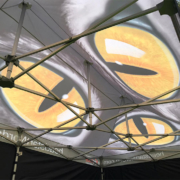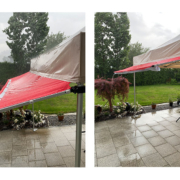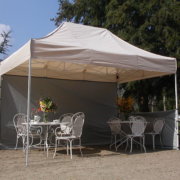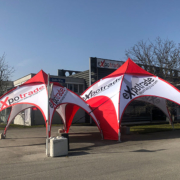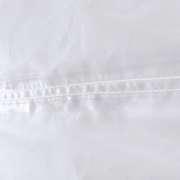Advice 1
If possible, look for a “branded product” and not a no-name tent!
Half the battle for a higher quality tent is a branded product, which is usually better quality than a no-name product. A branded product is not called a branded product for nothing, as there is usually a well thought-out “brand” behind it and forms the basis for long-term high-quality production. The manufacturer and the importers or dealers of the brand make a conscious decision in favor of a brand because they want to develop and service a market over the long term. A poor quality product would only damage the reputation of the brand and thus also the reputation of the tent manufacturer or seller. So when you buy a branded product, you can largely rely on the fact that great care has been taken in the choice of materials, which is especially important in terms of the stability of the scissor tent. Branded products are sometimes more expensive than NN products, but this is mostly due to the fact that more know-how and, above all, higher quality materials are used in these products, which ultimately drive the product price up. In the case of NN products, the focus is usually only on keeping the price as low as possible, since you are not “committed” to any brand. It is therefore advisable to invest a little more money, which then pays off and pays off or amortizes in the long term and that usually has an impact on the stability of the tent. Quality is also important for a market stand, as it is usually set up several times a month or even a week and is therefore quite used during a year. Ultimately, the better quality and therefore a long-lasting product proves itself.
Advice 2
Determine the most suitable size of the marketstand
It is of no use if you think you have to have a certain size of tent for your market tent if the market organizer does not provide you with the necessary space for it. Due to the variety of sizes – at Expotrade there are e.g. 12 different tent sizes in different designs. If you need even more space, the folding pavilions can of course also be linked together to form a larger unit. So to say a tentcity as a marketplace. With this information, you can then make specific inquiries at a tent manufacturer.
Advice 3
Which tent frame do I use
This question is tied to various circumstances. How often do I use the market stall? If you would like to use your market foldingtent weekly or several times a month, then the tent type “expotent PREMIUM” from Expotrade is recommended. This frame has an Aluminum octagon profile and can be automatically adjusted with a passage height of 200-230cm “at no extra charge”. So if you need more space or a special height for your sales products, for example, then this tent is definitely the perfect solution for your project. 230cm passage height means approx. 30cm more height than with conventional folding tents, which normally only reach up to 200 cm passage height. Thanks to the 30cm more height, you still create a cozy atmosphere in the market stall and you don’t feel so “crushed” because the scissor or cross frame of the folding pavilion is higher above your head. How much weight can I still load in my vehicle or trailer? If your vehicle or trailer has generally reached the weight limit with your sales products, then of course a lighter folding tent frame is recommended. However, this means having to make some compromises in terms of stability and possibly also quality. The lighter expotent folding tent frames are e.g. the expotent Budget or Budget PRO frame. Both frames are made of anodized aluminum with a hexagonal profile. Due to the small savings measures, these foldable racks were only designed with a passage height of up to 200 to a maximum of 210cm. Nevertheless, these are still very good racks and you can use them 50 times or more per year without any problems. What volume can I still load in my car, transport or trailer? The different tent types and folding tent sizes also mean different requirements in terms of volume. For example, a 3x3m tent is packed smaller than a 4x4m folding tent. Therefore, ask the manufacturer about the packaging size of the respective market pavilion if you have space problems when transporting it. How much can the market stall cost? The different gazebo sizes and designs naturally result in different prices. If your budget for the market tent is limited, you may have to save on the pavilion frame and adjust the type accordingly.
Advice 4
suitable accessories for stabilizing the market-tent
Regardless of whether your tent is a marketstall (market tent), exhibition tent, party tent, garage tent, event tent or the like, a stabilization of the pavilion may be necessary for all these areas and even more.
Lashing straps and pegs/pegs:
With branded products such as the expotent folding tent from Expotrade Group, lashing straps and pegs (also called pegs) are included in the folding tent frame as standard. In the robust carrying bag of the frame there are suitable storage compartments on the inside so that all parts can be stowed away nicely and thus not get lost. So if you stand with your folding tent on soft ground, then we recommend tensioning the tent down with the supplied tensioning straps. These are primarily attached to the corners and, depending on the size of the tent, also in the middle and then braced at an angle to the ground and attached to the ground with pegs. The tension of the straps can then be adjusted and tightened or tensioned as required. With the expotent folding tent, there is also a “red” loop attached to the tensioning belt, which indicates the pulling of this loop and, when the belt is tensioned, also warns of a possible trip hazard.
Footplates/weights:
Market tents often stand on cobbled or asphalted streets and cannot be secured with conventional pegs. Here it is advisable to buy so-called footplates or weights. At expotent gazebos there are such foot plates with 15kg and 25kg weight. Depending on the size of the tent, it is advisable to use the heavier weights, as the wind can have a force that should not be underestimated. With expotent folding tents, the weight is simply placed on the inside of the tent on the triangular base of the folding tent. Due to the triangular shape of the weight plate, the plate closes positively with the shape of the tent and there are no outwardly protruding parts that could lead to tripping hazards. In addition, this also ensures that any side walls that may be attached to the tent also form-fit with the tent. The expotent weights also have a Velcro strip integrated into the plate, which is simply looped around the tent stand when the plate is placed on the stand and then attached to the plate again. This Velcro fastening prevents the plate from slipping off in strong winds and movements of the tent. The footplates can also be stacked on top of one another in order to use even more weight depending on the needs and size of the tent.
Connecting rods DIAGONAL:
the patented solution from Expotrade for wind problems. A patented solution that is only available from expotent! A pole attached “diagonally” between the legs of the folding tent stabilizes the market stand with a double effect! Due to the rigid design of this diagonal pole, pulling and pushing forces occurring on the folding pavilion are optimally absorbed and the tent is thus kept in perfect shape. This diagonal connection looks like the scissor profile in the roof structure of the folding tent, but is fixed between the legs at eye level. A telescopically extendable Aluminum profile facilitates fixation and the plastic screw connections around the support leg can be adapted to almost all common folding tent profiles using the supplied inserts. This means that the expotent diagonal connecting rod can also be attached to other folding tents from competitors. If you frequently pitch your tent in windy areas and want adequate protection from the wind, Expotrade’s diagonal connecting rod is the perfect solution to your problem. In addition, this stabilization bar also protects against “bulging of the sidewalls” in strong winds. In strong winds, the side walls attached to the tent are like a sail in the wind and naturally form a large wind attack surface on the tent. When the diagonal bar is installed, the side wall is caught by the crossbar and therefore it is practically impossible to tear the Velcro fasteners or the side wall fastening. Ask about the expotent special solutions office(at)expotradegroup.com or by phone +43 5576 73600
Horizontal connecting rods:
There is also the option of using a horizontally mounted pole between the legs of your market tent. This horizontal connecting rod is primarily fixed to the legs at a height of approx. 1 m using a screw lock. Branded products usually also come with a vertical leg to provide support in the middle. This supports the horizontal telescopic rod and prevents bending over large spans such as 4,5 m in length. Half-height side walls, for example, can then also be fixed to this horizontal bar. Thanks to the full-surface printing, even more advertising space can of course be used and, for example, a market table behind it can be covered for advertising purposes. In the case of expotent folding tents, these poles are also packed in a handy carrying bag so that nothing can be lost.
Advice 5
Don’t leave your customers out in the rain!
With expotent folding tents, there is also the option of expanding the folding pavilion into a real MARKET TENT. For this purpose there is e.g. the CANOPY, which is attached to the normal folding tent frame with a rod. Expotrade has developed a plastic clip that can be used for many folding tents available on the market. Regardless of whether you have a square, hexagonal or octagonal profile for the folding tent frame, these mounting brackets can easily be adapted to these tent profiles using interchangeable “inserts”. The canopy then protrudes approx. 70 cm above the normal folding tent and thus offers rain or weather protection for the customers, who can thus admire your products on the market table in the tent in the dry. Expotent canopies also have a unique “rain gutter” built in, so that the accumulated water can run off to the left and right of the awning and does not drip down the entire width. In addition, with this new type of canopy construction there are no “water sacks / water pockets” as usual, as the rainwater can run down through a net in the fabric into the rain gutter provided. The expotent canopy (also known as the awning) can also be adjusted as required thanks to a sophisticated system. This canopy awning offers you an additional 70cm more weather-protected sales area.
You can find further information or advice here: office(at)expotradegroup.com or by calling +43 5576 73600 www.expotradegroup.com

